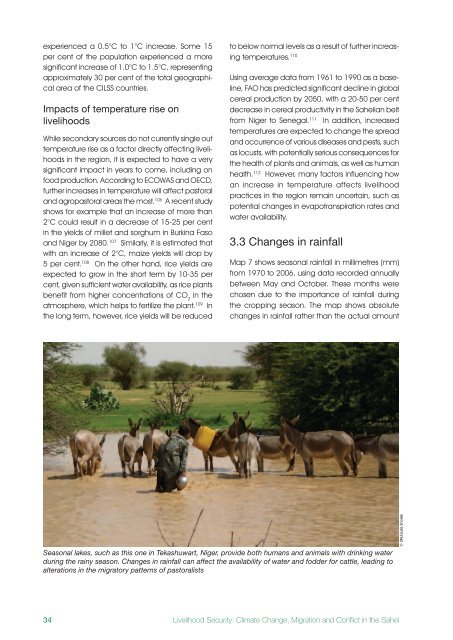Livelihood Security: Climate change, conflict and migration in - UNEP
Livelihood Security: Climate change, conflict and migration in - UNEP
Livelihood Security: Climate change, conflict and migration in - UNEP
Create successful ePaper yourself
Turn your PDF publications into a flip-book with our unique Google optimized e-Paper software.
experienced a 0.5°C to 1°C <strong>in</strong>crease. Some 15<br />
per cent of the population experienced a more<br />
significant <strong>in</strong>crease of 1.0°C to 1.5°C, represent<strong>in</strong>g<br />
approximately 30 per cent of the total geographical<br />
area of the CILSS countries.<br />
Impacts of temperature rise on<br />
livelihoods<br />
While secondary sources do not currently s<strong>in</strong>gle out<br />
temperature rise as a factor directly affect<strong>in</strong>g livelihoods<br />
<strong>in</strong> the region, it is expected to have a very<br />
significant impact <strong>in</strong> years to come, <strong>in</strong>clud<strong>in</strong>g on<br />
food production. Accord<strong>in</strong>g to ECOWAS <strong>and</strong> OECD,<br />
further <strong>in</strong>creases <strong>in</strong> temperature will affect pastoral<br />
<strong>and</strong> agropastoral areas the most. 106 A recent study<br />
shows for example that an <strong>in</strong>crease of more than<br />
2°C could result <strong>in</strong> a decrease of 15-25 per cent<br />
<strong>in</strong> the yields of millet <strong>and</strong> sorghum <strong>in</strong> Burk<strong>in</strong>a Faso<br />
<strong>and</strong> Niger by 2080. 107 Similarly, it is estimated that<br />
with an <strong>in</strong>crease of 2°C, maize yields will drop by<br />
5 per cent. 108 On the other h<strong>and</strong>, rice yields are<br />
expected to grow <strong>in</strong> the short term by 10-35 per<br />
cent, given sufficient water availability, as rice plants<br />
benefit from higher concentrations of CO 2 <strong>in</strong> the<br />
atmosphere, which helps to fertilize the plant. 109 In<br />
the long term, however, rice yields will be reduced<br />
34<br />
to below normal levels as a result of further <strong>in</strong>creas<strong>in</strong>g<br />
temperatures. 110<br />
Us<strong>in</strong>g average data from 1961 to 1990 as a basel<strong>in</strong>e,<br />
FAO has predicted significant decl<strong>in</strong>e <strong>in</strong> global<br />
cereal production by 2050, with a 20-50 per cent<br />
decrease <strong>in</strong> cereal productivity <strong>in</strong> the Sahelian belt<br />
from Niger to Senegal. 111 In addition, <strong>in</strong>creased<br />
temperatures are expected to <strong>change</strong> the spread<br />
<strong>and</strong> occurrence of various diseases <strong>and</strong> pests, such<br />
as locusts, with potentially serious consequences for<br />
the health of plants <strong>and</strong> animals, as well as human<br />
health. 112 However, many factors <strong>in</strong>fluenc<strong>in</strong>g how<br />
an <strong>in</strong>crease <strong>in</strong> temperature affects livelihood<br />
practices <strong>in</strong> the region rema<strong>in</strong> uncerta<strong>in</strong>, such as<br />
potential <strong>change</strong>s <strong>in</strong> evapotranspiration rates <strong>and</strong><br />
water availability.<br />
3.3 Changes <strong>in</strong> ra<strong>in</strong>fall<br />
Map 7 shows seasonal ra<strong>in</strong>fall <strong>in</strong> millimetres (mm)<br />
from 1970 to 2006, us<strong>in</strong>g data recorded annually<br />
between May <strong>and</strong> October. These months were<br />
chosen due to the importance of ra<strong>in</strong>fall dur<strong>in</strong>g<br />
the cropp<strong>in</strong>g season. The map shows absolute<br />
<strong>change</strong>s <strong>in</strong> ra<strong>in</strong>fall rather than the actual amount<br />
Seasonal lakes, such as this one <strong>in</strong> Tekashuwart, Niger, provide both humans <strong>and</strong> animals with dr<strong>in</strong>k<strong>in</strong>g water<br />
dur<strong>in</strong>g the ra<strong>in</strong>y season. Changes <strong>in</strong> ra<strong>in</strong>fall can affect the availability of water <strong>and</strong> fodder for cattle, lead<strong>in</strong>g to<br />
alterations <strong>in</strong> the migratory patterns of pastoralists<br />
<strong>Livelihood</strong> <strong>Security</strong>: <strong>Climate</strong> Change, Migration <strong>and</strong> Conflict <strong>in</strong> the Sahel<br />
© UNU/Julie Snorek

















